How "The Simpsons" have managed to prevent Fama Sofas from sending any waste to dumps
It is a great satisfaction for us to be able to communicate that we have obtained the “ZERO WASTE” certification from AENOR.
This certification guarantees that more than 90% of a company’s industrial waste is valued. That means that all those residues are recycled or reused to create new raw materials, thus avoiding the landfill as their final destination.
In our case, the data obtained has surprised us, since we have achieved a 99,985% of recycled products. It means that out of the 265.350 kilos of waste that we have generated in the last 8 months, only a 0,015% of those residues have not been recycled.
We separate each type of waste to make possible their reusability, from the minor ones such as obsolete fluorescent tubes or filters, to the large quantity ones such as plastic, fabric, wood or foam.
This certification proves that any of our manufacturing process residue has gone to a dump. We are very proud of this fact, since, while we often see that many business decisions on this field are only to brag about, in our case we have achieved something that any other extensive manufacturing company, like us, had obtained before. We don’t talk about flashy actions such as purchasing an electric car, but about something much more relevant, we have actually managed to give our waste a second life, prevent it from ending up in a rubbish dump.
With this certification, we demonstrate that things can be done differently, plus, finding the right way to not to step into antieconomic measures; actually, quite the opposite, these decisions end up reversing positively in the company, but also in the environment.
These data are not the results of one- or two-years’ actions, our sustainability culture comes from many years ago. I remember when we moved to the current facilities 37 years ago, when almost no one was speaking about recycling and separating residues, we already placed 4 waste containers in the cafeteria to divide the waste, even tough the waste managers were not yet separating them and at the end everything was getting mixed again. This philosophy has always helped everyone to easy continue forward on this path. It’s a satisfaction for us to see how the new people in the team are adopting these habits in a natural way, from the production waste to food leftovers.
Certainly, in the past few years, we had to do some important changes in the production process and sometimes we found some reticence due the complications caused by those changes, but now it’s a huge satisfaction for us to see now how these same people who complained, are now very proud of what we have achieved.
I cannot resist telling a beautiful story behind this achievement, which has to do with the cartoon series “The Simpsons”. It sounds like a joke, but it has been the trigger of having obtained such an impressive data and the subsequent certification.
This is the story of how “The Simpsons” have managed to prevent Fama Sofas from sending any waste to landfills, and, even more, it can be the starting point to stop generating thousands of tons of waste worldwide in the upholstery and fashion sector.
Four years ago, when we started preparing the environmental management ISO 14001 certification, we started gathering the data of each waste type we were generating. We had an incredible data: 100% of wood and sawdust residues, were being sold to make pellets and new wood boards. 100% of the fiber leftovers were being sold to manufacture teddies. Every foam scraps also were being sold to be crushed and reused as fillings by other companies. With the paper, cardboard and plastic waste the same thing happened.
But then we discovered that we had a black spot at one stage of the production process: the remains of waste that came out of the fabric cutting machines. Here, three types of raw materials were being mixed: paper, plastic and fabric. When we analysed the data, it turned out that in one year we were generating 100.000 kg of industrial waste.
In those days, as a destiny coincidence (or not), I watched “The Simpsons” episode where Homer Simpson was in charge of the Springfield waste management, and he allowed all the surrounding cities to send all their waste to the Springfield landfill due to money interests. At the end, all the rubbish ended up coming out everywhere in the city causing a huge chaos. Those are the things that you watch on TV and make you think. I firmly recommend watching this episode to everybody, in order to understand what I’m talking about.
In this case some images are worth than a thousand words, there are many things that we ignore because we never face them, and coincidence or not, this episode made us see our activity from another point of view. Honestly, we had never thought we could generate that many industrial waste and this caused us a bit of anguish sensation.
Suddenly, we were seeing our 100.000 kgs and the ones from the rest of the companies in the sector being unloaded continuously in a large rubbish dump which wasn’t the one from “The Simpsons”, but the one in a neighbouring town…, and this image was etched in on our minds.
We began to investigate, and we were somehow relieved when we found out that a large part of this waste called "Industrial waste" made up of paper, cloth and plastic was crushed to obtain a solid fuel used in industries, which has a lower level of contamination emissions than the fossil fuels such as coal or diesel.
We looked for different waste management options and we finally managed to get all our “Industrial waste” used to create fuels and to ensure that it did not end up in any landfill.
Probably, if this story from the cartoon series had not appeared, we wouldn’t have realised the problem we had in our hands, but the story does not end up here.
As we have mentioned, these remains were used to create fuel, but it was still too much garbage, and we began to devise a solution to be able to eliminate this type of waste. Thereby, after more than two years of work, carrying out tests and more tests, we have achieved an important innovation that allows us to solve this problem. We have managed to separate those 100.000 kg of mixed industrial waste. They are now 70.000 kg of fabric waste and 30.000 kg of plastic waste, two raw materials that can be recycled separately. The first one to create new fabrics, or new products such as home insulations, and the second one to generate new plastics.
Now, we would dream with the idea that this solution reaches the rest of sofa manufacturers, as also all the fashion industries in the globe. The result could be amazing, being able to reduce millions and millions of garbage tons worldwide. To achieve this goal, we have requested the help of Lectra, the world's largest cutting system multinational company, so that they can spread this innovation among their customers around the world. Our intention is to share this technology with all the interested companies in order to help them stop sending waste to dump.
This project has been selected for “THE 101 BUSSINESS EXAMPLES OF ENVIRONMENTAL ACTIONS”
When my granddaughters will be a bit older, I will be able to tell them how thanks to an episode from “The Simpsons”, we saw clearly that we had to change the way of doing things.
THIS IS NOT THE END, ACTUALLY IT IS THE BEGINNING.
The data obtained is not the finish line, but rather the starting one, as even tough the data is very good, we know that we could do it much better. We have always opted for continuous improvements, and we never stop starting new improvement projects. Nowadays we have the stunning quantity of 108 started improvement projects related to sustainability and the environment.
In the last few years, we have started tens of projects related to sustainability, some very important like the one said, and others of a smaller magnitude, but at the end, the sum of all those projects, big and small ones, enables us to go forwards and contribute to leave a better world to our younger generations.
In a few months we will inaugurate our new facilities where we have applied several innovations focused on their maximum sustainability, like a triple water circuit which collect rainwater to use it for showers or for flush toilets, or a clever automatic window system which opens or closes them at night to refresh the facilities in a natural way, or the inner courtyard in the factory which provides natural light to the building and at the same time protects from cold or from heat; all those projects, small and large, have allowed us to get the energy rating for our facilities.
Already 10 years ago we stopped using dissolvent glues, nowadays all our wood boards are formaldehyde free, we replaced the diesel hitting for a pellets one, we installed solar panels to generate electricity, and tens of important actions, but also little improvements as eliminating the individual bins to separate the crushed coffee from the organic garbage in order to use it as fertilizer, or reuse the supplier’s cardboard boxes for our shipments; thereby we could continue filling up a few more pages.
If you want to know more about our environmental policy or our sustainable declaration, you will find much more information on our website: www.fama.es. We don’t just put a picture of the Canadian woods, but we explain in detail what we actually do with every kind of waste.
THE MOST AMBITIOUS PROJECT: TO RAISE UP THE CIRCULAR ECONOMY TO THE TOP.
Finally, as we cannot stop, we announce the next big project we have launched, which is to ensure, during the next five years, that no waste leaves our production plant.
It’s all about raising up the circular economy to the maximum level, to be able to recycle all our residues internally to generate new raw materials or components used in the production process. It is a big challenge, a difficult one, but I know we will achieve it. To explain it with two examples: instead of sending the cardboard or paper leftovers out for recycling, we are looking to buy the machine which makes the typical egg carton and use it to generate internally protection elements for the sofas, or to purchase the machine to crush the wood leftovers and be able to make our own pellet. Those are just two examples with two kinds of waste, but we have started projects, some of them in collaboration with Cetem, for the rest of the residues, looking to create new compounds with crushed remains.
A thrilling project with very ambitious objectives that now seems very unreachable, but we are sure that we will finally achieve it. We follow then the sustainable development objectives under these premises and the objectives we have reached are a good example of it.
The environmental care is an enormous responsibility we have, perhaps we need to stop speaking with empty words, and refuse the extremist and radical positions that in many cases forget about a fundamental aspect, the people wellbeing. We firmly believe that the people wellbeing and the environmental care are perfectly compatible and the steps we are taking are a good example of it.
Our future is in our hands.
Félix López Gil OCHP Fama Sofas.


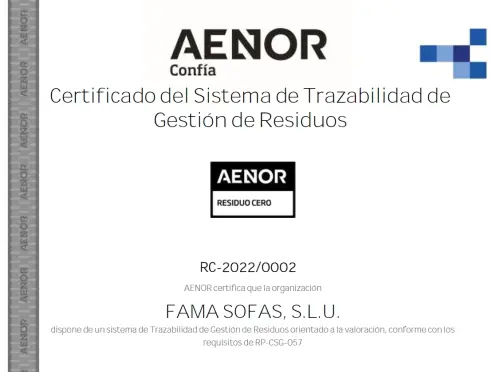
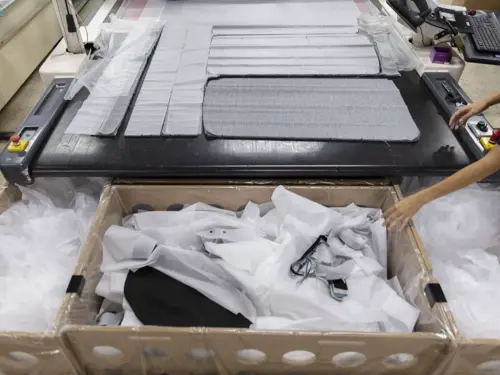

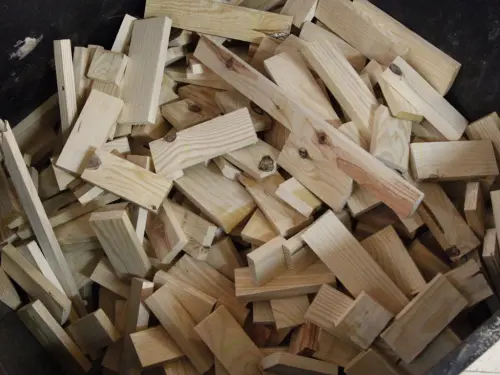
.jpg)
.jpg)
.jpg)
.jpg)






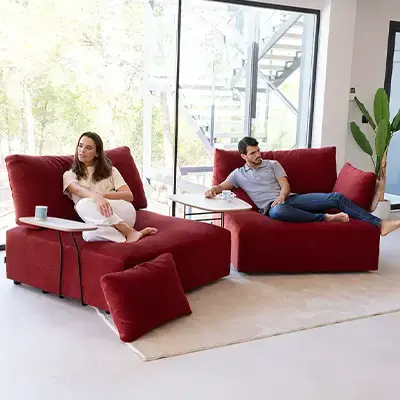

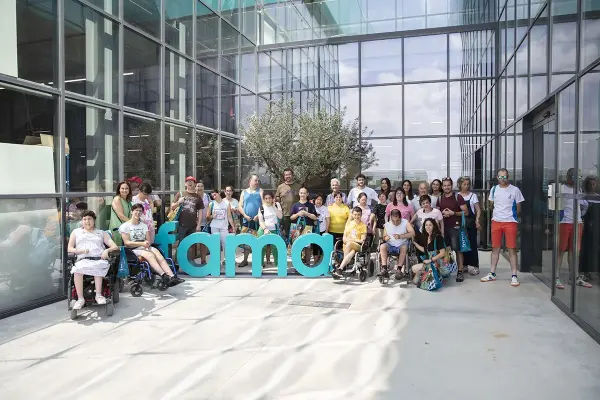





Astyork
21 de october 2023
sgtamilan
25 de november 2024
Leave a comment